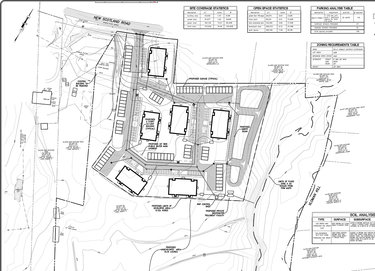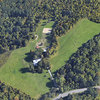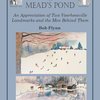Spurred by apartment proposal, New Scotland boards look to clear up zoning language
NEW SCOTLAND — A 72-unit apartment proposal has New Scotland’s zoning, planning, and town boards re-examining a portion of the town’s hamlet zoning law adopted in 2018.
In June, Richard Long came before the zoning board, proposing six two-story buildings on property he owns at 2080 New Scotland Road, approximately a quarter-mile from Town Hall.
Representatives for Long said there were different housing standards in the hamlet district: one says only one home per acre is allowed and another allows a residential unit every 3,000 square feet.
Earlier, Building Inspector Jeremy Cramer had decided that the one-acre zoning applied and allowed the application to move forward to the zoning board, where Long would be able to challenge Cramer’s one-unit-per-acre determination.
During the zoning board’s July meeting, Chairman Jeffrey Baker said the board was being asked by Long to make an interpretation that was unconnected to his application. “We’re being asked to resolve this apparent inconsistency, to provide guidance to the applicants, to [Cramer], and going forward,” Baker said.
The board was being asked to clarify a provision in the zoning that not only impacts Long’s project, but every property in the hamlet district addressed by that section of the code.
If the interpretation had been project-specific, the zoning board would have undertaken a State Environmental Quality Review Act review of the Long proposal, Baker said. And if the board were to agree with Long’s interpretation of the code, then future developers would be “able to come forward and say, ‘We want to do multi-family without the one-acre requirement,’” he said, in effect changing a section of the code.
Jurisdiction
Donald Zee, Long’s attorney, said at the July zoning board meeting that, when there’s ambiguity in a zoning code, “the courts have repeatedly found that you have to interpret it in favor of the property owners,” and that his client would be seeking the more favorable multi-family housing density.
Zee also made it a point to say the proposal is what New Scotland was looking for when it adopted hamlet-specific zoning in addition to a town-wide comprehensive plan in 2018, for example, by adding diversity to a largely single-family housing stock in addition to creating more affordable housing when the only new housing coming on the market in recent years is located in luxury-home developments.
Additionally, while it’s not explicitly senior housing, “many tenants would be retired or above the age of 50,” according to the narrative filed with Long’s May submittal to the town.
Zee then reiterated his earlier point, summarized by board member Dean Sommer, “In light of the ambiguity, you’re saying any ambiguity should be interpreted, if you will, in the favor of the applicant.” Sommer then said the vagueness of the code was such “that I didn’t feel comfortable being an unelected official changing the zoning law, because the town board passes zoning law.”
“I’m uncomfortable with this,” Sommer said of having the zoning board weigh in with its own reading of the zoning code, “because it has such broad consequences.”
Zee pointed out that New Scotland’s elected officials already have a remedy in place for such a situation: “The town board chose you to be on [the zoning board] and you have accepted the role,” Zee said to Sommer. “And, under town law as well, as I believe under the zoning code here, the zoning board of appeals is charged with the task of interpreting the zoning code.”
Baker asked Zee to do some research on “inherently inconsistent density provisions,” to see if “there are any cases closely on points, or relevant, where you have one density restriction in one part of the district and another language somewhere else. And the zoning board said they both can’t stand, how can we pick?”
Because, the chairman said, “I’m not aware of a similar type of case.”
The already-short-staffed zoning board (Lance Moore stepped down to take a job with the town) is down a chairman at its August meeting, and set a public hearing for its September meeting on Long’s code interpretation appeal.
“The public hearing is on the interpretation question,” board member Erin Casey said; there will be no discussion of “the merits of this project, or even the details of the project.”
Planning board
The town board was due to discuss an update to hamlet zoning at its Wednesday meeting, while the planning board on Monday, in a unanimous vote, recommended that the zoning board should uphold Cramer’s one-unit-per-acre determination.
Long’s application had been referred to the planning board for its interpretation.
The planning board’s chairman, Charles Voss, said the “parcel in question is really situated kind of on the fringe of the hamlet zone … So it’s a slightly different complexion there in terms of the existing character of the neighborhood, [then] it may be up at the corner of [routes] 85 and 85A.”
In his opinion, Voss said, when the New Scotland Hamlet District rezone took place, the idea was for the dense development to occur closer to Stonewell Plaza and what’s now Fred the Butcher, referencing the Ron Kay development approved by the board in 2017 that is now getting off the ground and is located between those two sites.
Voss also pointed out Long’s proposed development is in the expansion area of the hamlet district, where the expectation was “the density would change, slightly decrease.”
Board member Christine Galvin pointed to the subsection of the hamlet law relating to Base Density that states, “For parcels served by public water and sewer or private centralized sewer systems the following development densities apply for residential and non‐residential uses: Residential uses. The maximum allowed residential density use is one (1) dwelling unit per acre.”
The language in the code “is very clear,” Galvin said, for “parcels served by public water and sewer … the maximum amount provided residential density is one dwelling unit per acre.”
For his 3,000-square-foot argument, Long is referring to a section of a table included in the Base Density subsection titled “Density and Bulk standards,” Galvin said, “OK, so, [it] starts using the term standard, and throughout it there, it’s referring to the square-footage.”
Voss said he thought, if someone were trying to understand density, the unit of measurement would be a housing unit because the allowable residential lot square-footage for other types of multi-unit housing — attached single‐family and two‐family — is given “per unit.”
But there is no “per” phrase associated with multi-family housing in the table, it just says “unit.”
“Two of them are consistent,” Voss said of the “per unit” phrasing, “and one just doesn’t have language written in it.”
Galvin said, “There seems to be a single word, arguably, missing.”
“It’s just a discrepancy, the way the code is written,” Voss said.
“But that being said, that’s the letter of the law right now; it’s not there,” Voss said.



